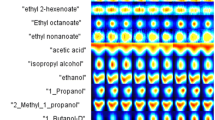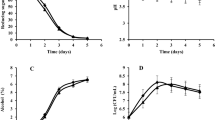Abstract
Given the lack of research in the traditional cider making field when compared to the efforts devoted to winemaking, this work focused on the effects of controlled inoculation of the malolactic fermentation (MLF) on the sensory properties of cider. MLF develops spontaneously in cider making at industrial level. In this work, industrial cider samples were inoculated with selected indigenous Oenococcus oeni strains and the benefits on the aroma and flavour in cider production compared to non-inoculated ciders were evaluated. Randomly amplified polymorphic DNA PCR was used to monitor strain colonization ability, outnumbering the indigenous microbiota, after completion of the alcoholic fermentation at industrial scale (20,000 l). Aroma-active compounds of experimentally inoculated ciders were analysed by HPLC and GC–MS, and sensory profiles were determined by fractioning aroma extracts using reversed-phase HPLC. Principal component analysis allowed the identification of relationships and differences among ciders with or without inoculation, including several highly appreciated commercial ones obtained under spontaneous conditions. Under controlled inoculation conditions, not only could MLF be shortened by half but, interestingly, enhancement of aroma complexity and flavour resulted in ciders enriched with a higher fruity note. In addition, important aromatic groups analysed here had not been previously described, thus affording deeper knowledge on aroma characterization of apple cider.






Similar content being viewed by others
References
Antalick G, Perello MC, de Revel G (2010) Development, validation and application of a specific method for the quantitative determination of wine esters by headspace-solid-phase microextraction-gas chromatography-mass spectrometry. Food Chem 21:1236–1245
Antalick G, Perello MC, de Revel G (2012) Characterization of fruity aroma modifications in red wines during malolactic fermentation. J Agric Food Chem 60:12371–12383
Apostolopoulou AA, Flouros AI, Demertzis PG, Akrida-Demertzi K (2005) Differences in concentration of principal volatile constituents in traditional Greek distillates. Food Control 16:157–164
Bauer R, Dicks LMT (2004) Control of malolactic fermentation in wine. A review. South Afr J Enol Vitic 25:74–88
Bertrand A (1981) Formation des substances volatiles au cours de la fermentation alcoolique. Incidence sur la qualité du vin. In: Colloque Société Française de Microbiologie, Reims, pp 251–267
Bertrand A, de Revel G, Ingargiola MC (1990) Some aspects of malolactic fermentation in wines. In: Alko’s colloquium on enology, proceedings of the French scientific week. Centre Culturel Francüais, Helsinki, pp 265–280
Boelens MH, van Gemert L (1993) Volatile character-impact sulfur compounds and their sensory properties. Perfum Flavor 18:29–39
Boidron JN, Chatonnet P, Pons M (1988) Influence du bois sur certaines substances odorantes des vins. Connaissance de la vigne et du vin 22:275–293
Chatonnet P, Dubourdieu D, Boidron JN, Pons M (1992) The origin and incidence of ethylphenol in red wines. J Sci Food Agric 60:165–178
Chatonnet P, Dubourdieu D, Boidron JN (1999) The influence of Brettanomyces/Dekkera yeasts and lactic acid bacteria on the ethylphenol content of red wines. Am J Enol Vitic 50:545–549
Davis CR, Wibowo D, Eschenbruch RE, Lee TH, Fleet GH (1985) Practical implications of malolactic fermentation: a review. Am J Enol Vitic 36:290–301
Degré R (1993) Selection and commercial cultivation of wine yeast and bacteria. In: Fleet G (ed) Wine microbiology and biotechnology. Harwood, Switzerland, pp 421–447
de Revel G, Pripis-Nicolau L, Barbe J-C, Bertrand A (2000) The detection of α-dicarbonyl compounds in wine by formation of quinoxaline derivatives. J Sci Food Agric 80:102–108
Ferreira V, Hernández Orte P, Escudero A, López R, Cacho J (1999) Semipreparative reversed-phase liquid chromatographic fractionation of aroma extracts from wine and other alcoholic beverages. J Chromatogr A 864:77–88
Guth H (1997) Identification of character impact odorants of different white wine varieties. J Agric Food Chem 45:3022–3026
Henick-Kling T, Sandine WE, Heatherbell DA (1989) Evaluation of malolactic bacteria isolated from Oregon wines. Appl Environ Microbiol 55:2010–2016
Herrero M, de la Roza C, García LA, Díaz M (1999) Simultaneous and sequential fermentations with yeast and lactic acid bacteria in apple juice. J Ind Microbiol Biotechnol 22:48–51
Herrero M, Cuesta I, Garcia LA, Diaz M (1999) Changes in organic acids during malolactic fermentation at different temperatures in yeast-fermented apple juice. J Inst Brew 105:191–195
Herrero M, Garcia LA, Diaz M (2003) The effect of SO2 on the production of ethanol, acetaldehyde, organic acids and flavor volatiles during industrial cider fermentation. J Agric Food Chem 51:3455–3459
Izquierdo Cañas PM, García Romero E, Gómez Alonso S, Palop Herreros MLL (2008) Changes in the aromatic composition of Tempranillo wines during spontaneous malolactic fermentation. J Food Compos Anal 21:724–730
Jarvis B, Forster MJ, Kinsella WP (1995) Factors affecting the development of cider flavour. J Appl Bacteriol (Symp Suppl) 79:5S–18S
Le Quéré JM, Husson F, Renard CMGC, Primault J (2006) French cider characterization by sensory, technological and chemical evaluations. Lebenson Wiss Technol 39:1033–1044
Lee SJ, Noble AC (2003) Characterization of odor-active compounds in Californian chardonnay wines using GC–olfactometry and GC–mass spectrometry. J Agric Food Chem 51:8036–8044
Lopez R, Ferreira V, Hernandez P, Cacho JF (1999) Identification of impact odorants of young red wines made with Merlot, Cabernet Sauvignon and Grenache grape varieties: a comparative study. J Sci Food Agric 79:1461–1467
Madrau MA, Mangia NP, Murgia MA, Sanna MG, Garau G, Leccis L, Caredda M, Deiana P (2006) Employment of autochthonous microflora in Pecorino Sardo cheese manufacturing and evolution of physicochemical parameters during ripening. Int Dairy J 16:876–885
Martorell N, Martí MP, Mestres M, Busto O, Guasch J (2002) Determination of 4-ethylguaiacol and 4-ethylphenol in red wines using headspace-solid-phase microextraction-gas chromatography. J Chromatogr A 975:349–354
Mestres M, Busto O, Guasch J (2000) Analysis of organic sulphur compounds in wine aroma. J Chromatogr A 881:569–581
Nedovic VA, Durieux A, Van Nedervelde L, Rosseels P, Vandegans J, Plaisant AM, Simon JP (2000) Continuous cider fermentation with co-immobilized yeast and Leuconostoc oenos cells. Enzym Microb Technol 26:834–839
Picinelli A, Suárez B, Moreno J, Rodríguez R, Caso-García LM, Mangas JJ (2000) Chemical characterization of Asturian cider. J Agric Food Chem 48:3997–4002
Pineau B, Barbe J-C, Van Leeuwen C, Dubourdieu D (2009) Examples of perceptive interactions involved in specific “red-” and “black-berry” aromas in red wines. J Agric Food Chem 57:3702–3708
Plutowska B, Wardencki W (2008) Application of gas chromatography–olfactometry (GC–O) in analysis and quality assessment of alcoholic beverages—a review. Food Chem 107:449–463
Pollien P, Ott A, Montigon F, Baumgartner M, Munoz-Box R, Chaintreau A (1997) Hyphenated headspacegas chromatography–sniffing technique: screening of impact odorants and quantitative aromagram comparisons. J Agric Food Chem 45:2630–2636
Pripis-Nicolau L, de Revel G, Bertrand A, Lonvaud-Funel A (2004) Methionine catabolism and production of volatile sulfur compounds by Oenococcus œni. J Appl Microbiol 96:1176–1184
Querol A, Barrio E, Huerta T, Ramón D (1992) Molecular monitoring of wine fermentations conducted by dry yeast strains. Appl Environ Microbiol 58:2948–2952
Reguant C, Bordons A (2003) Typification of Oenococcus oeni strains by multiplex RAPD-PCR and study of population dynamics during malolactic fermentation. J Appl Microbiol 95:344–353
Ribéreau-Gayon P, Dubourdieu D, Donèche B, Lonvaud-Funel A (2006) Handbook of enology: the microbiology of wine and vinifications, 2nd edn. Wiley, Chichester
Romano A, Perello MC, de Revel G, Lonvaud-Funel A (2008) Growth and volatile compound production by Brettanomyces/Dekkera bruxellensis in red wine. J Appl Microbiol 104:1577–1585
Ruiz P, Izquierdo PM, Seseña S, LM Palop (2009) Analysis of lactic acid bacteria populations during spontaneous malolactic fermentation of Tempranillo wines at five wineries during two consecutive vintages. Food Control 21:70–75
Ruiz P, Izquierdo PM, Seseña S, Palop ML (2010) Selection of autochthonous Oenococcus oeni strains according to their oenological properties and vinification results. Int J Food Microbiol 137:230–235
Ruiz-Barba JL, Cathcart DP, Wamer PJ, Jiménez-Díaz R (1994) Use of Lactobacillus plantarum LPCO10, a bacteriocin producer, as a starter culture in Spanish-style green olive fermentations. Appl Environ Microbiol 60:2059–2064
Sánchez A, Rodriguez R, Coton M, Coton E, Herrero M, García LA, Díaz M (2010) Population dynamics of lactic acid bacteria during spontaneous malolactic fermentation in industrial cider. Food Res Int 43:2101–2107
Sánchez A, Coton M, Coton E, Herrero M, García LA, Díaz M (2012) Prevalent lactic acid bacteria in cider cellars and efficiency of Oenococcus oeni strains. Food Microbiol 32:32–37
Satora P, Sroka P, Duda-Chodak A, Tarko T, Tuszynski T (2008) The profile of volatile compounds and polyphenols in wines produced from dessert varieties of apples. Food Chem 111:513–519
Silva Ferreira AC, Rodrigues P, Hogg T, Guedes de Pinho P (2003) Influence of some technological parameters on the formation of dimethyl sulfide, 2-mercaptoethanol, methionol, and dimethyl sulfone in port wines. J Agric Food Chem 51:727–732
Sumby KM, Grbin PR, Jiranek V (2010) Microbial modulation of aromatic esters in wine: current knowledge and future prospects. Food Chem 121:1–16
Talon R, Leroy S, Lebert I, Giammarinaro P, Chacornac JP, Latorre-Moratalla ML, Vidal-Carou MC, Zanardi E, Conter M, Lebecque A (2008) Safety improvement and preservation of typical sensory qualities of traditional dry fermented sausages using autochthonous starter cultures. Int J Food Microbiol 126:227–234
Vaillant H, Formisyn P, Gerbaux V (1995) Malolactic fermentation of wine: study of the influence of some physico-chemical factors by experimental design assays. J Appl Bacteriol 79:640–650
Wibowo D, Fleet GH, Lee TH, Eschenbruch RE (1988) Factors affecting the induction of malolactic fermentation in red wines with Leuconostoc oenos. J Appl Bacteriol 64:421–428
Xu Y, Zhao GA, Wang L (2006) Controlled formation of volatile components in cider making using a combination of Saccharomyces cerevisiae and Hanseniaspora valbyensis yeast species. J Ind Microbiol Biotechnol 33:192–196
Xu Y, Fan W, Qian MC (2007) Characterization of aroma compounds in apple cider using solvent-assisted flavor evaporation and headspace solid-phase micro-extraction. J Agric Food Chem 55:3051–3057
Zhang DS, Lovitt RW (2006) Performance assessment of malolactic fermenting bacteria Oenococcus oeni and Lactobacillus brevis in continuous culture. Appl Microbiol Biotechnol 69:658–664
Acknowledgments
Ainoa Sánchez is grateful to Fundación para el Fomento en Asturias de la Investigación Científica Aplicada y la Tecnología (FICYT) for its doctoral fellowship BP06-052. The authors are thankful to the cider making industry for providing samples and full collaboration. The authors are also indebted to the members of the test panel for their help and patience.
Author information
Authors and Affiliations
Corresponding author
Rights and permissions
About this article
Cite this article
Sánchez, A., de Revel, G., Antalick, G. et al. Influence of controlled inoculation of malolactic fermentation on the sensory properties of industrial cider. J Ind Microbiol Biotechnol 41, 853–867 (2014). https://doi.org/10.1007/s10295-014-1402-y
Received:
Accepted:
Published:
Issue Date:
DOI: https://doi.org/10.1007/s10295-014-1402-y




